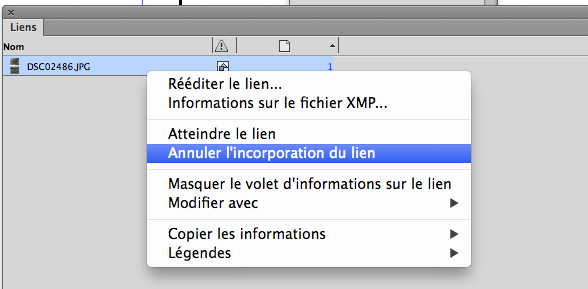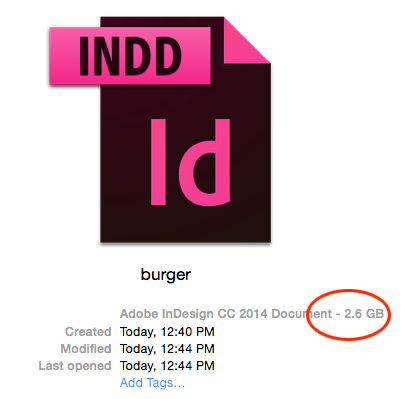Copy link to clipboard
Copied
What is the best procedure for embedding images in InDesign?
 1 Correct answer
1 Correct answer
The best procedure is to NEVER embed an image in InDesign. By default images are linked when you place them, and they should stay linked, not embedded. This keeps the file size down and makes work more efficient, and allows you to update the image.
Copy link to clipboard
Copied
The best procedure is to NEVER embed an image in InDesign. By default images are linked when you place them, and they should stay linked, not embedded. This keeps the file size down and makes work more efficient, and allows you to update the image.
Copy link to clipboard
Copied
The reason why I ask is because my printer told me to make sure all my layers are embedded when creating my PDF.
Copy link to clipboard
Copied
Then use the PDF/X-1a:2001 preset when exporting your PDF.
Copy link to clipboard
Copied
What does PDF/X-1a have to do with images in the PDF file? If you mean embedding fonts, most of the PDF export settings of InDesign by default embed all fonts. And if you want to go the route of PDF/X, we at Adobe most strongly recommend PDF/X-4 given that it provides for live transparency and color management in the resultant PDF file yielding a much more reliable and flexible workflow. (PDF/X-1a yields PDF with device-resolution and device-color space dependent output including flattened transparency!)
- Dov
Copy link to clipboard
Copied
The printer said the words embed layers not fonts.
Copy link to clipboard
Copied
Since there is no such thing as “embedding layers” either in InDesign or in PDF, either you misunderstood what the printer was telling you, the printer made a gaffe in telling you “layers” as opposed to something else (possibly “images”), or unfortunately, the printer doesn't know his *ss from his elbow.
Given that the issue was related to images, I suspect the printer was trying to tell you to embed the images in the InDesign document (as opposed to placing them via links) as a way of making sure that when the PDF was created, the full image, and not some low resolution proxy, was being exported.
That having been said, without seeing your original InDesign document and the resultant PDF file, it is virtually impossible to further second guess what was going on. What we can tell you is that (1) there is no such thing as “embedding layers” and (2) embedding images as opposed to placing with links is not best workflow practice.
- Dov
Copy link to clipboard
Copied
Hi, I'm totally new to InDesign.
My book will be all images. My printer wants a PDF file, so I thought InDesign would be the way to go.
But this business of linking to files on your computer when you are sending the file to a printer makes no sense. Also, IMO no one in their right mind in this day and age would want anyone accessing files on their computer.
Can you please advise how I can embed the images rather than link. (I can deal with redoing/embedding an image if I change it. It's the linking that's a serious problem.)
Thank you.
Its frustrating to be lured off track with technicalities; when all I want to do is to have Place embed the image (though InDesign only links placed images.)
Copy link to clipboard
Copied
This post is EIGHT YEARS OLD!
Never embed images in an InDesign document. They are embedded when you export the PDF.
I'm locking this discussion. If you have further questions, please start a new discussion.
Copy link to clipboard
Copied
InDesignCS4Student wrote:
The reason why I ask is because my printer told me to make sure all my layers are embedded when creating my PDF.
Re you sure he said layers, not fonts? You caanot "embed" a layer in a PDF (you can flatten them, though). InDesign automatically embeds all required fonts, unless they are restricted, when you export.
Copy link to clipboard
Copied
Here is what the printer said.
"Make sure all layers are embedded when creating the PDF"
One of the images I had placed in one of my document pages was not filling the entire page on their end.
Copy link to clipboard
Copied
InDesignCS4Student wrote:
Here is what the printer said.
"Make sure all layers are embedded when creating the PDF"
One of the images I had placed in one of my document pages was not filling the entire page on their end.
So does that image fill the entire page in your docment? Does it seem correct when you view the PDF on your system? Was the image layered?
What settings are you using to make the PDF?
Copy link to clipboard
Copied
To embed an image or any link for that matter into InDesign, right click on the Link (Links pallet) and select "Embed Link". Done.
Copy link to clipboard
Copied
Nice job. I'm glad someone just answered the question as opposed to lecturing the kid.
Copy link to clipboard
Copied
Embedding links is not the answer to the question. Links and layers are not synonymous in ID.
Copy link to clipboard
Copied
Thank you for the answer, I couldn't remember.
Copy link to clipboard
Copied
I take it that most of you haven't worked with a lot of print houses? The printer is simply asking the artist to embed any images (layers) in the file. I know that in his statement he actually said "Make sure all layers are embedded when creating the PDF", but if you have ever actually worked with a print house, you will hear them say stuff like that all the time. They just want to ensure that they don't have to deal with linked images. Why? Because most artists aren't well organized in their file structure, so when they upload files for processing, the linked images are often missing or broken and the poor guy at the print house has to deal with finding them. It's a major hassle for them. Embedded images fix all of that. And for all you "best practices" people out there, embedding images, or "layers" as the printer called them, is a best practice if you do it when you give it to the print house. File size has become less and less a factor in processing print jobs because memory now days is more than capable of handle the majority of it.
Best practice - link the images until you are finished creating the artwork, then embed the images before sending them to the print house. (And cut the guys some slack when they call them layers)
So my congratulations @Agrippa - the only one that answered the student's question, and answered it correctly. You, I would hire.
Copy link to clipboard
Copied
Nonsense. Best practice is to export and deliver a PDF.
And yes, I'm a pro, have worked with printers for years, and have held jobs as a pre-press tech.
Copy link to clipboard
Copied
This isn't always true, especially if edits may come in during the proofing stage. Or if you have some sort of merge list set up. It's easier for the print house to have the design files with everything embedded so they can make changes as needed. If you're sending a PDF you make it a lot more difficult for the printer to adjust things on the fly.
Copy link to clipboard
Copied
You know what makes it even more difficult? A completely corrupted InDesign file.
If you need to send the native files, it should be done using the file>package command leaving all of the links external.
Copy link to clipboard
Copied
It's easier for the print house to have the design files with everything embedded so they can make changes as needed.
What if they have to make a correction to the embedded art? Embedding and not including the link would make that much more difficult.
Copy link to clipboard
Copied
You can easily “unembedd” a placed file. I do not know the right term in English, but in French, it is: “Annuler l'incorporation du lien”

Copy link to clipboard
Copied
Right, I forgot that you can extract as well as relink, which gets back to the potential problem with embedding in complex docs—file size and performance hits.

Copy link to clipboard
Copied
Bullshit. Embedding images is the main cause of corrupted files. Package, but better to send a PDF/X-4.
Copy link to clipboard
Copied
Embedding images is the main cause of corrupted files
That may be, but then isn't that a fairly serious bug? And if it can't be fixed shouldn't Adobe remove the embed feature? Certainly there are cases where you can embed and file size and performance is not a problem—like a business card, postcard or single page ad.
-
- 1
- 2
Find more inspiration, events, and resources on the new Adobe Community
Explore Now


